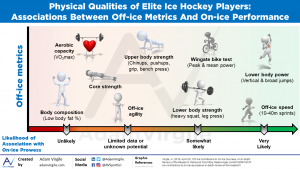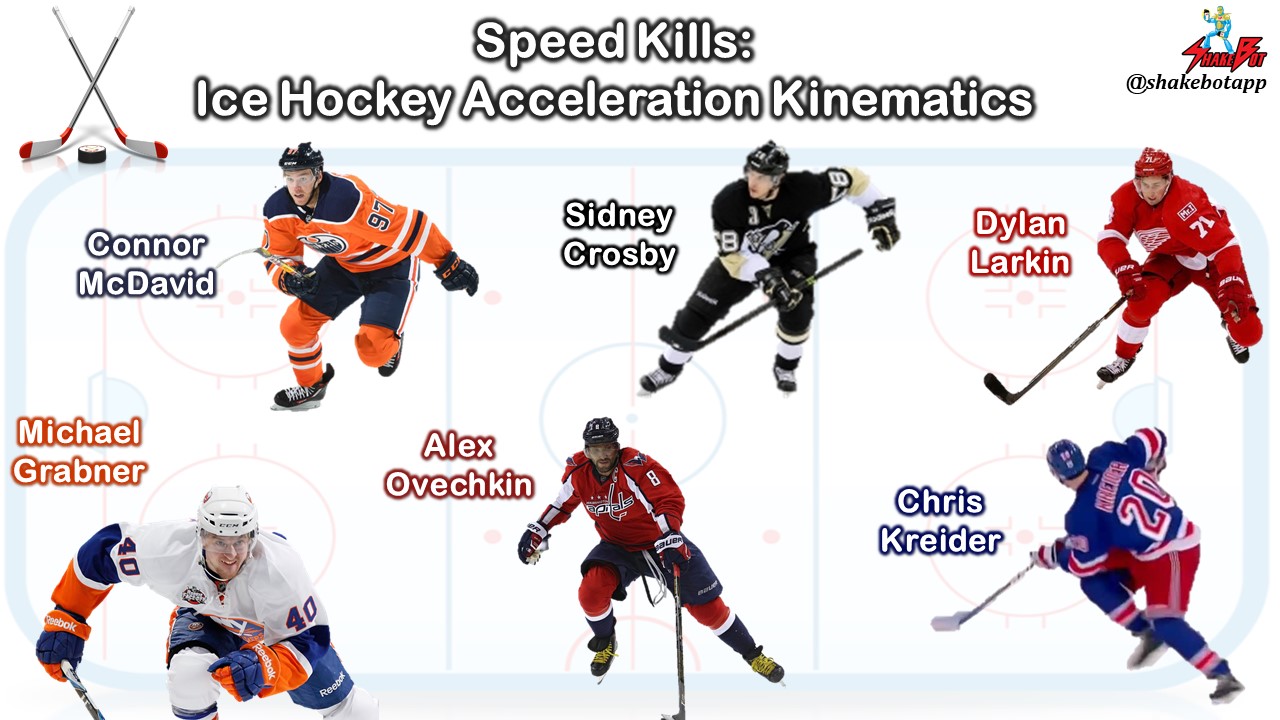Sporting injuries can be caused by contact (e.g traumatic) or non-contact (e.g overuse) mechanisms in nature, with contact injuries more often being associated with extrinsic risk factors, which are out of the control of the athlete in a single, identifiable incident [1-5].
Causes of Non-Contact Injuries
Although oftentimes due to a multifaceted cause, non-contact injuries are typically not as well defined by a single athletic event, and are often associated with accumulation of many ‘micro-traumatic’ repetitive movements controlled primarily by intrinsic risk factors [1-5]. It’s important to consider the multitude of potential intrinsic risk factors that affect non-contact injury occurrence in order to put preventative measures into place and to, hopefully, reduce the risk of injury occurrence. Lack of muscular strength, compromised range of motion (ROM), and previous injury, are all intrinsic risk factors thought to contribute to non-contact injury occurrence/recurrence [6-17]. Other intrinsic risk factors for non-contact injury include: loss of neuromuscular control (via fatigue) [18-23], drastic changes in training load [23-28], and low levels of fitness [28-31], among others. The nature of non-contact injury is multifaceted; no single intrinsic risk factor is the sole cause of injury.

The Role of the Hip in Ice Hockey
The importance of having healthy hips for ice hockey performance cannot be overstated. The locomotion within the ice hockey skating pattern requires unique hip involvement, compared with land-based maneuvers [32-38]. Increased motion and activity of hip abductors, external rotators, flexors, and extensors, are characteristics of on-ice acceleration and sprinting prowess [33-35, 39-42]. While the hip is responsible for the concurrent explosive abduction, external rotation, and extension during forward propulsion of skating [33-35, 43], hip flexion, adduction, and internal rotation predominate to stabilize and decelerate the lower limb during the recovery phase of the ice skating stride [13]. This synchrony of hip movements can put the hip in precarious positions, and when supplemented with the high loads/stresses that routinely pass through the hip during skating, the risk for non-contact hip injury increases [33-35, 39-41].
Better Players Have Greater Hip Involvement
These contributions at the hip joint are exacerbated in high-caliber players, compared with low-caliber players. High-caliber players achieve higher ice skating acceleration rates and sprint speeds than their low-caliber counterparts [32, 38, 44-48]. High-caliber players typically exhibit higher stride rates, as well as increased knee and hip flexion rates when loading during on-ice acceleration [38, 46-48]. Although a paucity of research currently exists, the greater amount of hip flexion when returning from the recovery phase of the skating stride is thought to allow for greater concentric contraction during the propulsive phase, resulting in the increased speed observed in high-caliber skaters [48]. Theoretically, the increased hip flexion should result in an increased amount of hip abduction, allowing the hip to maintain an ideal propulsive angle for efficient forward movement on-ice [49, 50].
Summary
The relationship among multiple intrinsic, modifiable risk factors seem to be the primary cause of non-contact injuries in sport, whereas contact (e.g traumatic) injuries are often associated with extrinsic risk factors, which are out of the control of the athlete. It’s quite clear that compromised hip function can drastically impair on-ice movement capabilities, which can increase risk for non-contact injury and reduce on-ice performance. The finer details of the ice hockey movement biomechanics reviewed must be appreciated in order to develop appropriate ice-hockey-specific hip screening protocols and training interventions. Click here to move on to Part 2, which outlays how common hip injuries occur and discusses what can be done to prevent them.
To see how susceptible the hip is to injury and the risk factors for groin strains, go here.
To see the different types of hip/groin injuries that can occur, go here.
To see the costs (financial and other) of injury, including hip injury, go here.
To see how to develop a hip screening and monitoring protocol, go here.
To see how to treat different types of hip pain, go here.
To see how early ice hockey specialization (i.e. year-round participation) can negatively impact the hips, go here.
Reference
- Collins, M. and Raleigh, S.M., 2009. Genetic risk factors for musculoskeletal soft tissue injuries. In Genetics and Sports (Vol. 54, pp. 136-149). Karger Publishers.
- Fuller, C.W., Ekstrand, J., Junge, A., Andersen, T.E., Bahr, R., Dvorak, J., Hägglund, M., McCrory, P. and Meeuwisse, W.H., 2006. Consensus statement on injury definitions and data collection procedures in studies of football (soccer) injuries. Scandinavian journal of medicine & science in sports, 16(2), pp.83-92.
- Hreljac, A., 2004. Impact and overuse injuries in runners. Medicine and science in sports and exercise, 36(5), pp.845-849.
- Hreljac, A.L.A.N., Marshall, R.N. and Hume, P.A., 2000. Evaluation of lower extremity overuse injury potential in runners. Medicine & Science in Sports & Exercise, 32(9), pp.1635-1641.
- Sharma, P. and Maffulli, N., 2006. Biology of tendon injury: healing, modeling and remodeling. Journal of Musculoskeletal and Neuronal Interactions, 6(2), p.181.
- Baumhauer, J.F., Alosa, D.M., Renström, P.A., Trevino, S. and Beynnon, B., 1995. A prospective study of ankle injury risk factors. The American journal of sports medicine, 23(5), pp.564-570.
- Blackburn, T., Guskiewicz, K.M., Petschauer, M.A. and Prentice, W.E., 2000. Balance and joint stability: the relative contributions of proprioception and muscular strength. Journal of sport rehabilitation, 9(4), pp.315-328.
- Ekstrand, J. and Gillquist, J., 1983. Soccer injuries and their mechanisms: a prospective study. Medicine and science in sports and exercise, 15(3), pp.267-270.
- Hewett, T.E., Myer, G.D., Ford, K.R., Heidt Jr, R.S., Colosimo, A.J., McLean, S.G., Van den Bogert, A.J., Paterno, M.V. and Succop, P., 2005. Biomechanical measures of neuromuscular control and valgus loading of the knee predict anterior cruciate ligament injury risk in female athletes: a prospective study. The American journal of sports medicine, 33(4), pp.492-501.
- Holder-Powell, H.M. and Rutherford, O.M., 2000. Unilateral lower-limb musculoskeletal injury: its long-term effect on balance. Archives of physical medicine and rehabilitation, 81(3), pp.265-268.
- Murphy, D.F., Connolly, D.A.J. and Beynnon, B.D., 2003. Risk factors for lower extremity injury: a review of the literature. British journal of sports medicine, 37(1), pp.13-29.
- Söderman, K., Alfredson, H., Pietilä, T. and Werner, S., 2001. Risk factors for leg injuries in female soccer players: a prospective investigation during one out-door season. Knee Surgery, Sports Traumatology, Arthroscopy, 9(5), pp.313-321.
- Tyler, T.F., Nicholas, S.J., Campbell, R.J. and McHugh, M.P., 2001. The association of hip strength and flexibility with the incidence of adductor muscle strains in professional ice hockey players. The American journal of sports medicine, 29(2), pp.124-128.
- Witvrouw, E., Danneels, L., Asselman, P., D’Have, T. and Cambier, D., 2003. Muscle flexibility as a risk factor for developing muscle injuries in male professional soccer players: a prospective study. The American journal of sports medicine, 31(1), pp.41-46.
- Worrell, T.W. and Perrin, D.H., 1992. Hamstring muscle injury: the influence of strength, flexibility, warm-up, and fatigue. Journal of Orthopaedic & Sports Physical Therapy, 16(1), pp.12-18.
- Whittaker, J.L., Small, C., Maffey, L. and Emery, C.A., 2015. Risk factors for groin injury in sport: an updated systematic review. Br J Sports Med, pp.bjsports-2014.
- Krosshaug, T., Steffen, K., Kristianslund, E., Nilstad, A., Mok, K.M., Myklebust, G., Andersen, T.E., Holme, I., Engebretsen, L. and Bahr, R., 2016. The vertical drop jump is a poor screening test for ACL injuries in female elite soccer and handball players: a prospective cohort study of 710 athletes. The American journal of sports medicine, 44(4), pp.874-883.
- Kirkendall, D. (1990). Mechanisms of peripheral fatigue. Medicine and Science in Sports and Exercise, 22(4), 444.
- Small, K., McNaughton, L., Greig, M. and Lovell, R., 2010. The effects of multidirectional soccer-specific fatigue on markers of hamstring injury risk. Journal of Science and Medicine in Sport, 13(1), pp.120-125.
- McLean, S.G., Fellin, R.E., Suedekum, N., Calabrese, G., Passerallo, A. and Joy, S., 2007. Impact of fatigue on gender-based high-risk landing strategies. Medicine and science in sports and exercise, 39(3), pp.502-514.
- Östenberg, A. and Roos, H., 2000. Injury risk factors in female European football. A prospective study of 123 players during one season. Scandinavian journal of medicine & science in sports, 10(5), pp.279-285.
- Howard, M.E., Cawley, P.W. and Losse, G.M., 1998. Effect of lower extremity muscular fatigue on motor control performance. Medicine and science in sports and exercise, 30(12), pp.1703-1707.
- Riemann, B.L. and Lephart, S.M., 2002. The sensorimotor system, part II: the role of proprioception in motor control and functional joint stability. Journal of athletic training, 37(1), p.80.
- Jones, C.M., Griffiths, P.C. and Mellalieu, S.D., 2017. Training load and fatigue marker associations with injury and illness: A systematic review of longitudinal studies. Sports medicine, 47(5), pp.943-974.
- Gabbett, T.J., 2016. The training-injury prevention paradox: should athletes be training smarter and harder?. Br J Sports Med, pp.bjsports-2015.
- Gabbett, T.J., Hulin, B.T., Blanch, P. and Whiteley, R., 2016. High training workloads alone do not cause sports injuries: how you get there is the real issue.
- Soligard, T., Schwellnus, M., Alonso, J.M., Bahr, R., Clarsen, B., Dijkstra, H.P., Gabbett, T., Gleeson, M., Hägglund, M., Hutchinson, M.R. and Van Rensburg, C.J., 2016. How much is too much?(Part 1) International Olympic Committee consensus statement on load in sport and risk of injury. Br J Sports Med, 50(17), pp.1030-1041.
- Murray, N.B., Gabbett, T.J., Townshend, A.D., Hulin, B.T. and McLellan, C.P., 2017. Individual and combined effects of acute and chronic running loads on injury risk in elite Australian footballers. Scandinavian journal of medicine & science in sports, 27(9), pp.990-998.
- Malone, S., Roe, M., Doran, D.A., Gabbett, T.J. and Collins, K.D., 2017. Protection against spikes in workload with aerobic fitness and playing experience: the role of the acute: chronic workload ratio on injury risk in elite Gaelic football. International journal of sports physiology and performance, 12(3), pp.393-401.
- Sarah, J., Gribbin, T.C., Lisman, P., Murphy, K. and Deuster, P.A., 2017. Systematic Review of the Association Between Physical Fitness and Musculoskeletal Injury Risk: Part 2—Muscular Endurance and Muscular Strength. The Journal of Strength & Conditioning Research, 31(11), pp.3218-3234.
- Malone, S., Owen, A., Mendes, B., Hughes, B., Collins, K. and Gabbett, T.J., 2018. High-speed running and sprinting as an injury risk factor in soccer: Can well-developed physical qualities reduce the risk?. Journal of science and medicine in sport, 21(3), pp.257-262.
- Buckeridge, E., von Tscharner, V. and Nigg, B.M., 2016, May. LOWER LIMB MUSCLE RECRUITMENT STRATEGIES DIFFER BETWEEN ELITE AND RECREATIONAL ICE HOCKEY PLAYERS. In ISBS-Conference Proceedings Archive (Vol. 33, No. 1).
- Bracko, M.R., 2004. Biomechanics powers ice hockey performance. Biomechanics, 2004, pp.47-53.
- Marino, G.W., 1983. Selected mechanical factors associated with acceleration in ice skating. Research quarterly for exercise and sport, 54(3), pp.234-238.
- Renaud, P.J., Robbins, S.M., Dixon, P.C., Shell, J.R., Turcotte, R.A. and Pearsall, D.J., 2017. Ice hockey skate starts: a comparison of high and low calibre skaters. Sports Engineering, 20(4), pp.255-266.
- Nagahara, R., Matsubayashi, T., Matsuo, A. and Zushi, K., 2014. Kinematics of transition during human accelerated sprinting. Biology open, 3(8), pp.689-699.
- Stull, J.D., Philippon, M.J. and LaPrade, R.F., 2011. “At-risk” positioning and hip biomechanics of the Peewee ice hockey sprint start. The American journal of sports medicine, 39(1_suppl), pp.29-35.
- Nagahara, R., Takai, Y., Kanehisa, H. and Fukunaga, T., 2018. Vertical Impulse as a Determinant of Combination of Step Length and Frequency During Sprinting. International journal of sports medicine.
- Bizzini, M., Notzli, H.P. and Maffiuletti, N.A., 2007. Femoroacetabular impingement in professional ice hockey players: a case series of 5 athletes after open surgical decompression of the hip. The American journal of sports medicine, 35(11), pp.1955-1959.
- Keogh, M.J. and Batt, M.E., 2008. A review of femoroacetabular impingement in athletes. Sports Medicine, 38(10), pp.863-878.
- Philippon, M.J., Weiss, D.R., Kuppersmith, D.A., Briggs, K.K. and Hay, C.J., 2010. Arthroscopic labral repair and treatment of femoroacetabular impingement in professional hockey players. The American journal of sports medicine, 38(1), pp.99-104.
- Kuhn, A.W., Noonan, B.C., Kelly, B.T., Larson, C.M. and Bedi, A., 2016. The hip in ice hockey: A current concepts review. Arthroscopy, 32(9), pp.1928-1938.
- Chang, R., Turcotte, R. and Pearsall, D., 2009. Hip adductor muscle function in forward skating. Sports Biomechanics, 8(3), pp.212-222.
- Peterson, B.J., Fitzgerald, J.S., Dietz, C.C., Ziegler, K.S., Ingraham, S.J., Baker, S.E. and Snyder, E.M., 2015. Division I hockey players generate more power than division III players during on-and off-ice performance tests. The Journal of Strength & Conditioning Research, 29(5), pp.1191-1196.
- Smith, D.J., Quinney, H.A., Steadward, R.D., Wenger, H.A. and Sexsmith, J.R., 1982. Physiological profiles of the Canadian Olympic Hockey Team (1980). Canadian journal of applied sport sciences. Journal canadien des sciences appliquees au sport, 7(2), pp.142-146.
- Roczniok, R., Stanula, A., Maszczyk, A., Mostowik, A., Kowalczyk, M., Fidos-Czuba, O. and Zaj?c, A., 2016. Physiological, physical and on-ice performance criteria for selection of elite ice hockey teams. Biology of sport, 33(1), p.43.
- Roczniok, R., Maszczyk, A., Stanula, A., Czuba, M., Pietraszewski, P., Kantyka, J. and Starzy?ski, M., 2013. Physiological and physical profiles and on-ice performance approach to predict talent in male youth ice hockey players during draft to hockey team. Isokinetics and Exercise Science, 21(2), pp.121-127.
- Upjohn, T., Turcotte, R., Pearsall, D.J. and Loh, J., 2008. Three-dimensional kinematics of the lower limbs during forward ice hockey skating. Sports biomechanics, 7(2), pp.206-221.
- Wilcox, C.R.J., 2015. The development and implementation of a hip injury screening protocol within elite ice hockey (Doctoral dissertation, University of Hull).
- De Koning, J.J., Thomas, R., Berger, M.O.N.I.Q.U.E., De Groot, G. and van Ingen Schenau, G.J., 1995. The start in speed skating: from running to gliding. Medicine and science in sports and exercise, 27(12), pp.1703-1708.
Want to be the first to know when new content is created? Please enter your email address below.



